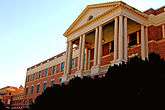Blackstone College for Girls
|
Above, the former administration building of Blackstone College for Girls. The facility now serves as the Virginia United Methodist Assembly Center. | |
Former names | Blackstone Female Institute |
|---|---|
| Type | School for young women |
| Active | February 15, 1892–1950 |
| Affiliation | Methodist Episcopal Church, South |
| Location | Blackstone, Virginia, USA |
Blackstone College for Girls was a private, religious school for young women in Blackstone, Nottoway County, in the U.S. state of Virginia. The school operated under the auspices of the Virginia Conference of the Methodist Episcopal Church, South between 1894 and 1950. The Virginia Department of Historic Resources acknowledged the significance of the site by erecting historical marker number K 174 in 1996.[1] Blackstone College is also designated as a site on the Civil Rights in Education Heritage Trail.[2] The school buildings still stand. Since 1955, the Virginia United Methodist Church has used the former school buildings as a conference center.[3]
History
The Blackstone Female Institute received its charter from the Virginia state legislature on February 15, 1892 and opened its doors to students in 1894. The Institute's facilities were built on six acres of land donated by the Blackstone Land Company.
In 1920 and 1922, two fires devastated the campus. The leaders of the college rebuilt the school on a smaller scale and reopened. In 1943, the college suspended operation for the duration of World War II, and the school buildings were used as apartments by servicemen and their families. Classes resumed in 1945, but dwindling enrollment and the Korean War forced the college to close in 1950.[3]
The facility was then purchased by the Virginia Methodist Conference (now Virginia United Methodist Conference) and converted into a retreat and conference center, which was opened in 1955. On February 17, 2016, another major fire destroyed the facility's separate boiler plant building, which had been recently renovated. In March, it was announced that the center would cease operations on May 7, 2016, thus bringing to an end over sixty years of service.
Curriculum
At the school's inception, its students completed five years of study, the equivalent of the eighth grade plus the four years of high school. Modeled on the Randolph-Macon System of schools, the Blackstone curriculum provided three programs: a basic high school education, preparation for university study, and teacher training.[4]
In addition to standard academic courses, the curriculum included three years of Bible studies.[3] Bishop Cannon advocated not only intellectual, but spiritual training as well. Morning chapel, Sunday sermons, and personal counseling were all part of the school week.
Faculty and administrators
James Cannon, Jr., pastor and later bishop of the Farmville Methodist Episcopal Church, South, was the school's first principal. Cannon was also the first president of the school.[3] Cannon was a prominent leader in the temperance movement until he was accused of misusing church money after the 1928 election.
George P. Adams, a merchant from Blackstone, was a staff member at the school from its founding through its final semester. Adams oversaw the school's buildings and grounds and also served as the Secretary-Treasurer of the Board of Managers.[3] The George P. Adams Memorial Scholarship Trust was established in his honor.
Students and alumnae

The first year the school operated, 29 boarders and 42 day students enrolled.[3] At peak enrollment, shortly before the 1920 fire, the student body numbered approximately 500 pupils.[1]
Notable alumna of Blackstone include actress Bea Arthur[5] and Violeta Chamorro, former president of Nicaragua.
References
Notes and citations
- 1 2 "Department of Historic Resources Highway Marker Search: Blackstone College". Retrieved 2009-08-30.
- ↑ "Civil Rights in Education Heritage Trail". Retrieved 2009-08-30.
- 1 2 3 4 5 6 "The Virginia United Methodist Assembly Center: Facilities: History". Retrieved 2009-08-30.
- ↑ Hohner, Robert A. (1999). Prohibition and Politics: the Life of James Cannon, Jr. (electronic). Columbia, SC: University of South Carolina Press. ISBN 1-57003-281-5. Retrieved 2009-09-05.
- ↑ Weber, Bruce (2009-04-25). "Bea Arthur, Star of Two TV Comedies, Dies at 86". New York Times. Retrieved 2013-02-04.
External links
Coordinates: 37°04′26″N 78°00′40″W / 37.0738°N 78.0111°W
